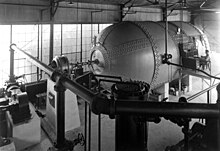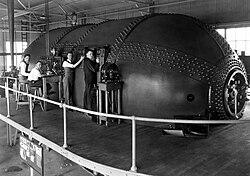
Wind tunnels are machines where an object is held stationary inside a tube, and air is blown around it to study the interaction between the object and the moving air. They are used to test the aerodynamic effects of aircraft, rockets, cars, and buildings. Different wind tunnels range in size from less than a foot across, to over 100 feet (30 m), and can have air that moves at speeds from a light breeze to hypersonic velocities.
In fluid dynamics, the drag equation is a formula used to calculate the force of drag experienced by an object due to movement through a fully enclosing fluid. The equation is:

The National Advisory Committee for Aeronautics (NACA) was a United States federal agency founded on March 3, 1915, to undertake, promote, and institutionalize aeronautical research. On October 1, 1958, the agency was dissolved and its assets and personnel were transferred to the newly created National Aeronautics and Space Administration (NASA). NACA is an initialism, i.e., pronounced as individual letters, rather than as a whole word.
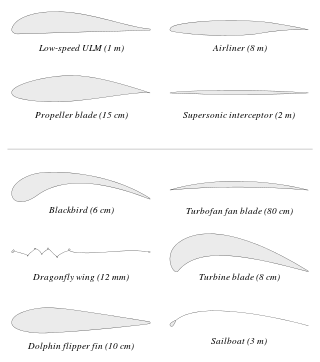
An airfoil or aerofoil is a streamlined body that is capable of generating significantly more lift than drag. Wings, sails and propeller blades are examples of airfoils. Foils of similar function designed with water as the working fluid are called hydrofoils.

Richard Travis Whitcomb was an American aeronautical engineer who was noted for his contributions to the science of aerodynamics.

Computational fluid dynamics (CFD) is a branch of fluid mechanics that uses numerical analysis and data structures to analyze and solve problems that involve fluid flows. Computers are used to perform the calculations required to simulate the free-stream flow of the fluid, and the interaction of the fluid with surfaces defined by boundary conditions. With high-speed supercomputers, better solutions can be achieved, and are often required to solve the largest and most complex problems. Ongoing research yields software that improves the accuracy and speed of complex simulation scenarios such as transonic or turbulent flows. Initial validation of such software is typically performed using experimental apparatus such as wind tunnels. In addition, previously performed analytical or empirical analysis of a particular problem can be used for comparison. A final validation is often performed using full-scale testing, such as flight tests.
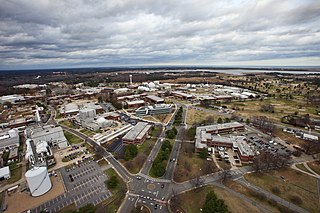
The Langley Research Center, located in Hampton, Virginia near the Chesapeake Bay front of Langley Air Force Base, is the oldest of NASA's field centers. LaRC has focused primarily on aeronautical research but has also tested space hardware such as the Apollo Lunar Module. In addition, many of the earliest high-profile space missions were planned and designed on-site. Langley was also considered a potential site for NASA's Manned Spacecraft Center prior to the eventual selection of Houston, Texas.

Robert T. Jones,, was an American aerodynamicist and aeronautical engineer for NACA and later NASA. He was known at NASA as "one of the premier aeronautical engineers of the twentieth century".

NACA stands for the National Advisory Committee for Aeronautics, which was a U.S. federal agency founded in 1915 to undertake, promote, and institutionalize aeronautical research. It played a crucial role in advancing aviation technology, including the development of airfoils, which are the cross-sectional shapes of wings and other aerodynamic surfaces. The NACA airfoil series is a set of standardized airfoil shapes developed by this agency, which became widely used in the design of aircraft wings.
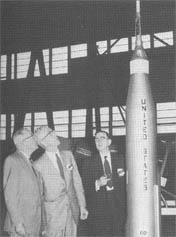
Ira H. Abbott was an American aerospace engineer. After graduating from MIT, Abbott started working for Langley Aeronautical Laboratory in 1929. He contributed significantly to the establishment of high-speed research programs and published numerous technical reports on aerodynamics. He eventually attained the post of assistant chief of research at Langley in 1945.
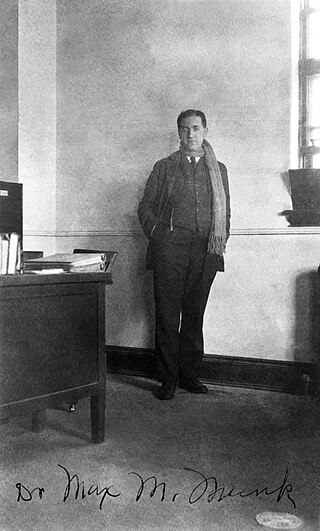
Max Michael Munk was a German aerospace engineer who worked for the National Advisory Committee for Aeronautics (NACA) in the 1920s and made contributions to the design of airfoils.
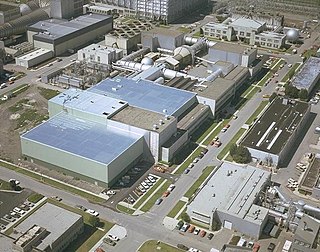
The Unitary Plan Wind Tunnel, located at the NASA Ames Research Center in Moffett Federal Airfield, Mountain View, California, United States, is a research facility used extensively to design and test new generations of aircraft, both commercial and military, as well as NASA space vehicles, including the Space Shuttle. The facility was completed in 1955 and is one of five facilities created after the 1949 Unitary Plan Act supporting aeronautics research.

Theodore Theodorsen was a Norwegian-American theoretical aerodynamicist noted for his work at NACA and for his contributions to the study of turbulence.

Eastman Jacobs (1902–1987) was a leading aerodynamicist who worked for NACA's Langley Memorial Aeronautical Laboratory from the 1920s to the 1940s. He was responsible for advancing many fields in aerodynamics, dealing particularly with wind tunnels, airfoils, turbulence, boundary layers, and Schlieren photography.

The Full-Scale Tunnel was a wind tunnel at NASA's Langley Research Center. It was a National Historic Landmark.
Aerodynamics is a branch of dynamics concerned with the study of the motion of air. It is a sub-field of fluid and gas dynamics, and the term "aerodynamics" is often used when referring to fluid dynamics
As the coalition of Bay Areas counties predicted when it lobbied for the creation of Moffett Federal Airfield in the late 1920s, the base's research program and facilities catalyzed the development of numerous private technology and aerospace corporations, among them Lockheed Martin and the Hiller Aircraft Corporation.
The Virginia Tech Stability Wind Tunnel is a medium-scale wind tunnel located at Virginia Polytechnic Institute and State University in Blacksburg, Virginia. With a test section measuring 6 by 6 ft and maximum wind speeds of approximately 262.6 ft/s (80.0 m/s), it is one of the largest university-owned wind tunnels in the United States, and is used for a wide variety of research projects within the college as well as being contracted out for commercial use, especially product testing. Professor William Devenport is the current director, and Dr. Aurelien Borgoltz is the assistant director.

John Stack (1906–1972) was an aerospace engineer. He won the Collier trophy, in 1947 and 1951.

The Propeller Research Tunnel (PRT) was the first full-scale wind tunnel at the National Advisory Committee for Aeronautics (NACA) Langley Research Center, and the third at the facility. It was in use between 1927 and 1950 and was instrumental in the drag reduction research of early American aeronautics. In 1929, NACA was awarded its first Collier Trophy for the NACA cowling which was tested and developed using the Propeller Research Tunnel.
